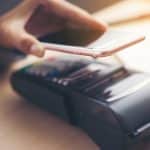Mobile Payment
Mobile payment, or M-payment, refers to the financial transaction carried out via a smartphone or other smart device.
Definition Mobile Payment
Transactions also include subscriptions to services or the purchase of products made online via a smartphone or other device. Paying with the mobile payment method saves time, is convenient and eliminates the need to carry a haptic credit card or even cash. There are several providers of payment applications on the mobile payment market and today’s smartphones have long had the integrated technology – keyword “electronic wallet“. However, it is also a fact that the uncertainty about paying by smartphone is still great among many users, especially in Germany – but it is diminishing. In the Nordic region, payments by electronic wallets are quite common.

Mobile Payment in Subscription Business
The oldest form of mobile payment is the so-called premium SMS or MMS. This form of payment was initially used mainly for ring tones and mobile game subscriptions. In the meantime, SMS payment has also spread to other business areas. The customer confirms the purchase or subscription by sending an SMS to a specific number. The corresponding amount is then debited from the mobile phone bill.
Mobile payment is therefore also a part of the subscription business. Another form of mobile payment is the card-based transaction. For example, customers can use the Amazon app to conveniently order and pay for a product by smartphone using the credit card already stored. Or you can use a mobile payment provider like Paypal or Klarna: The customer wants to order from a delivery service in a foreign city, but doesn’t want to go through the hassle of entering his credit card details? Simply select Paypal & Co. as the payment method and the payment is done.
The security of a mobile payment purchase
Mobile payment is secure. A high level of security is already guaranteed with contactless payment via NFC (Near Field Communication) using any smart device. The data transmitted with the NFC payment method is subject to highly complex encryption in accordance with banking standards. The same security standard is also achieved with other mobile money transfer forms. Namely, no details of the card are passed on, which provides more security.
Another factor that makes mobile payments generally very secure are the security checks by means of two-factor authentication, which is used for example when paying with the digital credit card (e.g. in Apple Wallet, Amazon Payments or Samsung Pay) or with other online payment services. Despite high convenience for the consumer, thanks to touch or face ID, mobile payment is therefore a very secure payment technology.
The NFC function
The NFC function is now the most widespread mode of operation in the field of mobile payment and is regarded as the technology of the future for the retail trade. The acronym stands for Near Field Communication. This is a technology that enables the secure transmission of payment information by radio between the smart device (which has the NFC chip integrated into its system) and the POS terminal.
The NFC transaction works according to a relatively simple standard: the smart device is simply held close enough to a reader and the payment is made automatically. Thanks to touch or face authentication, it is usually not necessary to enter the personal password, so the payment is instantaneous. This transaction often has a limit of 25 euros, which was set slightly higher during the Covid 19 pandemic to make contactless and thus more secure payment available to more people. If the payment amount is above this limit, it is usually necessary to enter a password or PIN code.
Conclusion: Mobile payment facilitates and accelerates transactions for subscriptions and product purchases
Many technology experts agree that the future belongs to mobile payment via smart device. This is evident at least in many countries where payment via this method is already an absolute standard and skepticism seems to be gradually disappearing. More and more consumers and business sectors are recognising the advantages of mobile payments, and with increasing use, concerns about security and the misuse of data and information are diminishing.
With the Covid 19 crisis, many people have increasingly shed their skepticism towards this payment service and thus towards online purchases and subscription services for fear of the life-threatening virus. Against this background, it can be assumed that the number of mobile money transfers will increase more strongly than planned in the future. According to a recent Bitkom survey, 71 percent of respondents can already imagine using more mobile payments in the future.

